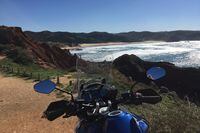I've just spent the day riding the 2016 Triumph Tiger Explorer in the South of Portugal. This is a major update to the liter-class ADV bike originally released in 2011, with just about everything getting some sort of refinement; but the big story is the electronic integration between the suspension, traction control, ABS, and engine-response modes, especially on the higher-end models. Like the Tiger 800, the Explorer is available in multiple model designations with different tiers of standard equipment: the cast-wheel Explorer is available in XR (manually adjustable suspension), XRX, and XRT (the latter two have semi-active suspension); while the more dirt-worthy spoke-wheel models for the U.S. market will be the XCX and XCA and both come equipped with the semi-active suspension.
Triumph is now using WP suspension (owned by KTM), and on the versions that have electronic control, it has taken a very different approach to tuning compared to KTM. Together with Continental, they have created a system that integrates engine response and suspension with ABS and traction control, so that a rider can select from different modes that really change the manners of the bike. There are a dizzying number of different parameters that are selectable, but the bike makes sensible groups out of them (Sport, Road, Rain, Off-road, plus a wildcard user configured mode called "Rider"), and makes it easy to punch a single button and select all the options you might want for a given situation at once. If you don't like the presets they came up with, you can change them and it will remember your preferences.
From the saddle, the bike is a treat to ride. The electronic suspension can be tuned independently of everything else at the touch of a button, and it really makes a difference. There are nine levels of damping from Sport (which is taut and precise), to Comfort (which is soft and even a touch wallowy). This is no gimmick, there is really a great amount of change in character, and it is really nice to match the suspension to the road condition as you go.
The 1215cc, 12-valve engine is exactly what you might expect from Triumph's signature triple—smooth down low, building torque in the midrange, and plenty of steam up top. I found it to be surprisingly competent in the dirt, the engine character and gear ratios don't make it a trials bike, but on flowing dirt roads the chassis was predictable and the bike was pleasant to ride. On twisty paved roads, it was easy to hit my lines, and on divided highway, the comfy ergonomics and big windscreen mean there is no hardship to endure. If there are any downsides to the bike, they mostly relate to its size and weight—while the bike works well, it can be bulky to handle, especially at lower speeds.
These are just my initial first impressions, so look for a more comprehensive review soon. But in the meantime, it seems that the big adventure bike segment has another serious player in the mix. This will be the right answer for the questions some folks are asking.

/cloudfront-us-east-1.images.arcpublishing.com/octane/GMG6KKHK4ZDLBFILW6L5UHJC4M.jpg)
/cloudfront-us-east-1.images.arcpublishing.com/octane/6BQBLTD22JHEFH2OBE5ZGY74NU.jpg)
/cloudfront-us-east-1.images.arcpublishing.com/octane/OVNMRSCISBB2FG4GQLQAYN56MU.JPG)
/cloudfront-us-east-1.images.arcpublishing.com/octane/7KSW4EGJWBGKFA62G4OARG7POU.jpg)
/cloudfront-us-east-1.images.arcpublishing.com/octane/OX5X6DCDXRBHBDLSLR2PRRJMSE.jpg)
/cloudfront-us-east-1.images.arcpublishing.com/octane/4FN63Z3XEVBMBDP3W6GFPLICRU.jpg)
/cloudfront-us-east-1.images.arcpublishing.com/octane/2CYHINRF5RA7VBO3PRJPVU5IBE.jpg)
/cloudfront-us-east-1.images.arcpublishing.com/octane/X7JX7MGA5ZBCDGDVAA2LKUGCTQ.jpg)
/cloudfront-us-east-1.images.arcpublishing.com/octane/7TO4TMPM6JBJJPBWUMT35TJHHA.jpg)
/cloudfront-us-east-1.images.arcpublishing.com/octane/3CANJMY47BH6BNPDAODAUD3CWQ.jpg)
/cloudfront-us-east-1.images.arcpublishing.com/octane/4IGJJZ6HWNAIHJ343U7CUH4WC4.jpg)
/cloudfront-us-east-1.images.arcpublishing.com/octane/BP5NOY5NPVGOZIDU5FN7M42JMA.jpg)
/cloudfront-us-east-1.images.arcpublishing.com/octane/XH2ETEU4NVGDFNQO2XT2QQS5LU.jpg)
/cloudfront-us-east-1.images.arcpublishing.com/octane/TGJNNI474VFXFMS3YQDRIEKEFY.jpg)
/cloudfront-us-east-1.images.arcpublishing.com/octane/5QAQVX645VA3LKJFZ3C4Y2DTPI.jpg)
/cloudfront-us-east-1.images.arcpublishing.com/octane/45O2MZU525ATPB5GRG422ZTU54.jpg)
/cloudfront-us-east-1.images.arcpublishing.com/octane/WEWXDN2F2BD3DJYUJJX4RZIALA.jpg)
/cloudfront-us-east-1.images.arcpublishing.com/octane/VPDWRXQWRVGULBY7Z3JRGPTR2I.jpg)
/cloudfront-us-east-1.images.arcpublishing.com/octane/56QNDMMUA5EA3OCJINPCI2QZGA.jpg)
/cloudfront-us-east-1.images.arcpublishing.com/octane/BHOJALDF55CPXGFWVLVKBPYZZI.jpg)
/cloudfront-us-east-1.images.arcpublishing.com/octane/BRQMHRCC4FH5HK4D3HUMG6XEKM.jpg)
/cloudfront-us-east-1.images.arcpublishing.com/octane/2CPX3CKQZFFT5H2ISBRTCIAUPY.jpg)
/cloudfront-us-east-1.images.arcpublishing.com/octane/W6JSA4VWCFFDDAAN3AAWO6ZTPE.jpg)
/cloudfront-us-east-1.images.arcpublishing.com/octane/KJ34QPKSPFASHEGWY6FP7Z6C4M.jpg)